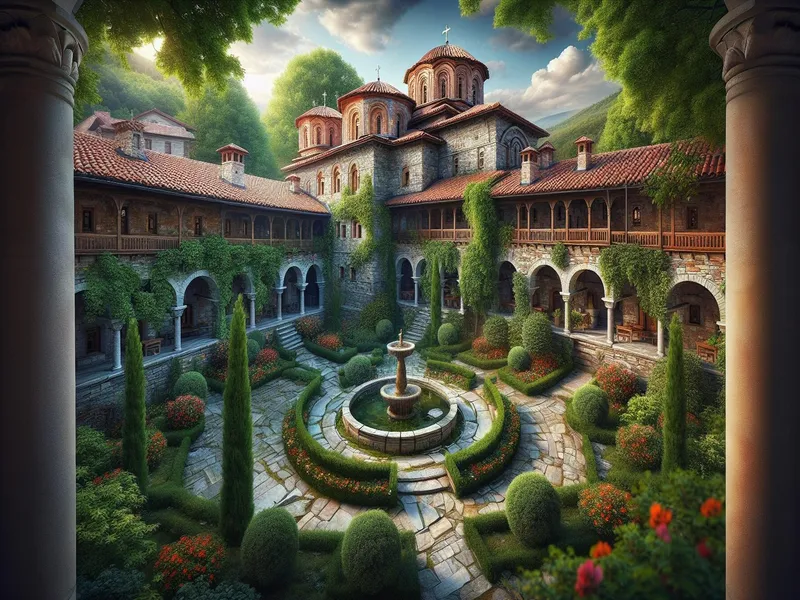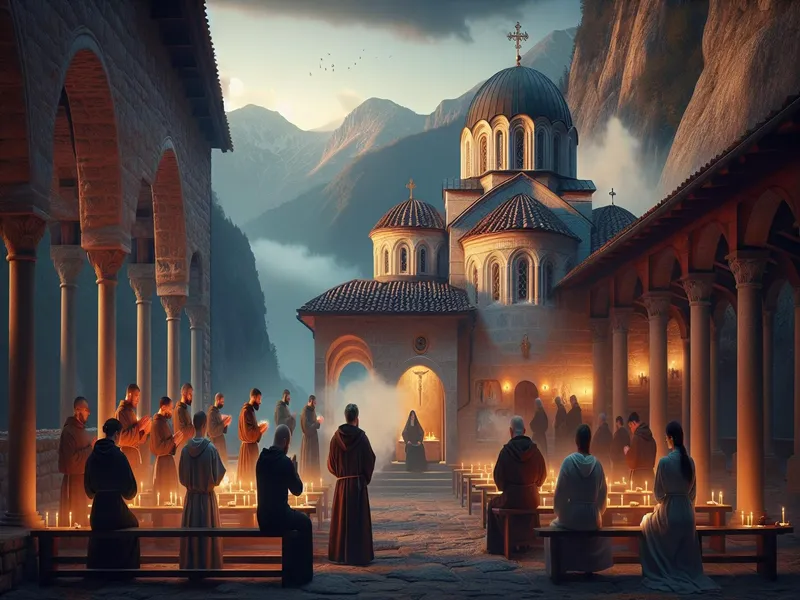the rich history and serene beauty of Bulgarian monasteries. Explore ancient frescoes, tranquil courtyards, and vibrant culture on your next backpacking adventure!

Historical Overview
So, let’s jump into the juicy past of Bulgarian monasteries! These places aren’t just about prayer and reflection; they’ve got some seriously cool history etched into their walls.
The Early Days
Back in the day, around the 4th century AD, monastic life started to take root in Bulgaria. Christianity was spreading like wildfire, and people wanted a quiet spot to dedicate themselves to faith. Think of it as ancient backpacking but with more praying and less hiking. St. Athanasius Monastery, one of the oldest (and coolest) ones, dates back to this period.
Medieval Flourish
Fast forward to the Middle Ages ️, these monasteries began popping up all over Bulgaria. They weren’t just spiritual havens; they were cultural hubs too. Monks copied manuscripts by hand—no printing presses back then! This is where you’d find some of the earliest examples of Bulgarian literature.
Fun Fact:
- Rila Monastery: Founded in the 10th century by St. John of Rila, it’s like Hogwarts for monks!
Ottoman Rule
Then came the Ottomans in the 14th century . While many monasteries faced destruction during this time, they also became secret spots for preserving Bulgarian culture and language—a bit rebellious if you ask me! Imagine sneaking around with precious books instead of contraband music tapes.
Revival Period
By the 18th and 19th centuries , Bulgaria saw a cultural revival known as “The National Revival.” Monasteries played a massive role here too. They turned into schools teaching kids more than just religious stuff—think math lessons next to fresco painting classes!
Checklist: What You’ll See
- Frescoes: Detailed wall paintings telling Biblical stories.
- Woodcarvings: Intricate designs often found on doors or iconostases (altar screens).
- Manuscripts: Ancient texts that are literal treasures!
Personal Anecdote
I remember visiting Bachkovo Monastery once—it felt like stepping into another era . Wandering through its serene courtyards while listening to birds chirping was almost meditative. And those frescoes? Absolutely stunning! You get this overwhelming sense that you’re walking through pages of history.
- Plan Your Trip: Many monasteries have guesthouses—perfect for an overnight stay.
- Dress Modestly: Out of respect when entering these sacred spaces.
- Leave No Trace: Keep nature pristine; pack your trash out.
Bulgarian monasteries offer more than historical insight—they provide a slice-of-life experience from different eras in an incredibly picturesque setting ✨
Architecture And Design

Bulgarian monasteries are a feast for the eyes, each one unique yet sharing common architectural traits that tell stories of resilience, artistry, and spirituality.
Interior Features
Stepping inside a Bulgarian monastery feels like entering another world. The walls are often adorned with vibrant frescoes depicting biblical scenes and saints. These intricate artworks date back centuries and have been meticulously preserved or restored over time. I remember walking through Rila Monastery’s main church; it felt like being in an art gallery where every piece had a soul.
- Wooden Iconostases: Many monasteries feature stunning wooden iconostases (screens separating the nave from the sanctuary) carved with incredible detail. These are not just religious symbols but masterpieces of craftsmanship.
- Dimly Lit Chambers: Candlelight flickers off gold-leaf icons, creating an ambiance that’s both mystical and serene.
You’ll also find ancient manuscripts stored in some libraries within these monasteries—real treasures for history buffs! Imagine holding a book copied by monks centuries ago!
Exterior Features
The exterior architecture of Bulgarian monasteries is just as compelling. These structures often blend seamlessly into their natural surroundings, enhancing their tranquil vibe.
- Stone Walls: Thick stone walls give these buildings a fortress-like appearance—a necessity during times of invasion.
- Red Tile Roofs: Characteristic red tile roofs add to the picturesque quality. They’re practical too, shedding snow easily in winter.
- Courtyards and Gardens: Many monasteries boast beautiful courtyards filled with flowers and fountains. Walking through them feels like stepping back in time.
Some even have defensive towers! For instance, Bachkovo Monastery has a tower from the Middle Ages that offers panoramic views if you’re up for the climb.
These architectural features make visiting Bulgarian monasteries not just a spiritual journey but also an aesthetic adventure.
Cultural Significance

Bulgarian monasteries are more than just places of worship. They’re cultural hubs that have played a vital role in shaping the nation’s identity.
Religious Practices
You know how some folks find peace in yoga or meditation? For many Bulgarians, monasteries offer that same solace through their religious practices. These sacred spaces host daily rituals and ceremonies that date back centuries. Imagine walking into a dimly lit chapel, the air thick with incense, and hearing chants echoing off ancient stone walls. It’s like stepping into another world.
Backpackers might appreciate knowing these monasteries often welcome visitors to observe services—just remember to dress modestly (think long sleeves and pants). I’ve found it fascinating to see how faith is practiced differently around the globe. In Bulgaria, you might witness monks engaging in vespers (evening prayers) or hear heart-stirring liturgies sung by choirs.
Here’s a quick checklist for visiting:
- Dress Code: Long sleeves and pants
- Timing: Plan visits around service times for an authentic experience
- Etiquette: Be respectful; photography is often restricted during services
Community Impact
Monasteries aren’t just spiritual retreats; they’ve historically been community lifelines too. During Ottoman rule, they were secret safe havens where Bulgarian culture and language were kept alive. Picture this: monks huddled over manuscripts, copying texts by candlelight while outside forces threatened their way of life.
Today, these monasteries still play a crucial role in local communities. They provide education, support social causes, and even boost tourism—a win-win! When I visited Rila Monastery (a must-see), I chatted with locals who shared stories about how the monastery supports nearby villages through charity work and cultural programs.
Here’s why you should care:
- Historical Preservation: Helps keep Bulgarian history alive
- Educational Centers: Offers learning opportunities for all ages
- Tourism Boost: Provides income and jobs for local communities
So next time you’re planning an itinerary ️ through Bulgaria, consider adding a monastery visit to your list—not only will you get a dose of tranquility but also contribute to preserving this rich cultural heritage.
Notable Monasteries
Visiting Bulgarian monasteries is like stepping into a time machine. These places are brimming with stories and stunning architecture that’ll make any history buff or spiritual seeker feel right at home. Let’s jump into some of the most notable ones.
Rila Monastery
Rila Monastery is Bulgaria’s superstar monastery, hands down. Nestled in the Rila Mountains, it’s about 70 miles south of Sofia, making it a perfect day trip from the capital. This UNESCO World Heritage site dates back to the 10th century and boasts jaw-dropping frescoes and intricate wooden carvings that tell tales as old as time.
When I first walked through its gates, I felt like I’d stepped into another world. The vibrant colors of the frescoes almost seemed to dance in the sunlight. One thing you shouldn’t miss is the Tower of Hrelja—climb up for some killer views! If you’re into hiking, there are trails around that offer breathtaking scenery.
Quick Facts:
- Location: Rila Mountains
- Founded: 10th century
- Must-see: Tower of Hrelja, frescoes
Bachkovo Monastery
Bachkovo Monastery sits just 6 miles south of Asenovgrad and offers a mix of Byzantine, Georgian, and Bulgarian styles. Founded in 1083 by two Georgian brothers, it’s got this unique vibe that sets it apart from other Bulgarian monasteries.
I remember visiting during one of their religious festivals—the energy was electric! Pilgrims gathered around icons believed to have miraculous powers. Inside, you’ll find an ossuary with ancient murals dating back to its early days; it’s both eerie and fascinating.
Check It Out:
- Location: Near Asenovgrad
- Founded: 1083
- Highlights: Ossuary murals, religious festivals
Troyan Monastery
Troyan Monastery is about two hours’ drive from Sofia and totally worth every minute on the road. It’s famous for its National Revival architecture and colorful murals by Zahari Zograf—a big name in Bulgarian art history.
The place has this peaceful aura that’s hard to describe unless you’ve been there yourself. I loved wandering around its courtyard filled with flowers while listening to the monks chant their daily prayers—it’s serene yet invigorating at the same time.
- Location: Near Oreshak village
- Founded: Late 16th century
- Top Sights: Murals by Zahari Zograf, tranquil courtyards
Visiting Tips
Best Time To Visit
If you’re planning a trip to a Bulgarian monastery, timing can make all the difference. Spring and autumn are ideal. The weather’s mild, and you avoid the tourist crowds that flock in summer. Plus, the landscapes are stunning with blooming flowers or colorful fall foliage.
Winter visits offer a unique charm but come prepared for cold temperatures and potential snow. Some monasteries might be harder to access due to snow-covered roads. But, if you’re up for an adventure and love winter scenery, this could be your thing.
Pro Tip: If visiting during religious holidays like Easter or Christmas, expect vibrant ceremonies but also larger crowds. It’s a double-edged sword—immersive yet busy.
| Season | Pros | Cons |
|---|---|---|
| Spring (Apr-Jun) | Mild weather; fewer tourists; blooming nature | Occasional rain showers ️ |
| Summer (Jul-Aug) | Long days; warm temps ☀️ | Crowded; higher prices |
| Autumn (Sep-Nov) | Beautiful foliage ; pleasant weather | Cooler temps as winter approaches ❄️ |
| Winter (Dec-Mar) | Snowy landscapes ❄️; festive atmosphere | Cold temps; road accessibility issues |
Nearby Attractions
Bulgarian monasteries often sit in picturesque locations, offering more than just spiritual experiences. For instance:
- Rila Monastery: After exploring its frescoes and serene courtyards, head to Rila National Park for some hiking or visit Stob’s Pyramids—a natural wonder with unique rock formations.
- Bachkovo Monastery: Located near Plovdiv, Bulgaria’s cultural capital, you can enjoy ancient Roman ruins and vibrant street art after your monastery visit.
- Troyan Monastery: Nestled in the Balkan Mountains’ heartland, it’s perfect for combining with eco-trails or visiting the nearby town of Troyan known for its pottery and plum brandy (rakia).
Here’s a quick checklist of must-do activities around these monasteries:
Rila Monastery:
- Hike Seven Rila Lakes ️
- Discover Stob’s Pyramids ️
Bachkovo Monastery:
- Explore Plovdiv’s Old Town
- Enjoy street art tours
- Walk Balkan eco-trails
- Taste local rakia
Exploring Bulgarian monasteries offers more than just a visit to ancient buildings; it’s an immersive journey through time, culture, and spirituality. Each monastery stands as a testament to resilience and artistry, providing unique insights into Bulgaria’s rich heritage.
Whether you’re captivated by vibrant frescoes or serene courtyards, these sacred spaces promise an enriching experience. By visiting these remarkable sites, you not only enjoy their beauty but also contribute to preserving Bulgaria’s cultural legacy.
Plan your trip with respect and curiosity. Dress modestly and embrace the tranquility these monasteries offer. Discover the stories etched in every stone and painting they hold centuries of history waiting for you to explore.